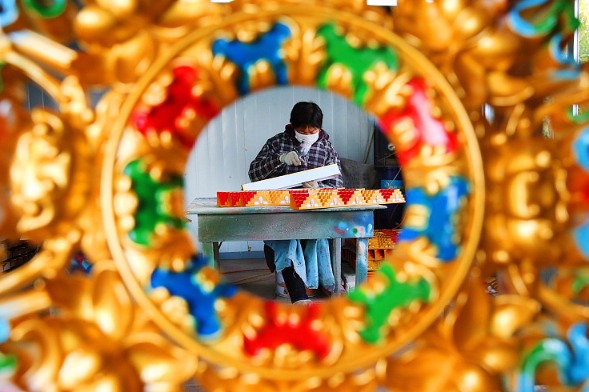Ancient Chinese-inspired ceramics see revival in Thailand
Sangkhalok ceramics, an ancient product of the Silk Road and a combination of both Chinese and Thai cultures, are now being manufactured again and are winning new-found popularity due to the ceramics' unique colors and motifs. Forty years ago, a Thai farmer came across some ancient ceramic wares with distinctive detailing while he was plowing his fields.
The farmer, Prasert Mahothorn, was mesmerized by the vivid blue color and detailed patterns featuring fish and flowers. After that he devoted himself to studying the ancient techniques used to produce such spellbinding and beguiling artifacts.
The Sangkhalok ceramics originally uncovered by Prasert can be dated back to the Sukhothai Kingdom period (1238-1583) and the Ayutthaya kingdom period (1351-1767).
In the 1970s, more than 200 kilns were also found in the Si Satchanalai region, adjacent to Sukhothai city.
| From left: A Sangkhalok-style celadon elephant rider figurine displayed at the Southeast Asian Ceramics Museum in Bangkok University; the remains of an ancient Sangkhalok ceramic kiln displayed in the Si Sathanalai Historical Park, northern Thailand's Sukhothai province; a pottery artisan draws Sangkhalokstyle glaze patterns on an earthen base in a ceramics workshop in Si Satchanalai. Photos by Li Mangmang / Xinhua |
Locals set up a private museum to collect the excavated ceramic wares from this area and an entire village specializing on manufacturing new Sangkhalok ceramics emerged.
In a studio packed with Chinese porcelain, 72-year old Prasert told Xinhua that these delicate artifacts are exceedingly beautiful and that it was their beauty that drove him to learn how to make these ceramics when he was younger.
Imitating the motifs found on authentic ancient ceramic artifacts and combining them with other patterns he learned from books, Prasert's works, with their unique style, won him some Thai businesspeople as customers.
Once his business had become successful, Prasert set up a studio to teach his family members and residents of the village the technique of making Sangkhalok ceramics.
Though there is a local museum, most of the excavated ceramic artifacts are now kept by the Southeast Asian Ceramics Museum of Bangkok University, which now boasts a collection of more than 16,000 ancient ceramic wares, and is the the biggest such collection in Thailand.
Ceramics from ancient China arrived in Thailand by Silk Road trade routes and inspired the Thai craftsmen at the time. The local craftsmen at the time went on to imitate the Chinese technique of manufacturing and thus Sangkhalok ceramics were born, explained Pariwat Thammapreechakorn, curator of the Southeast Asian Ceramics Museum.
"There were ceramics indigenous to ancient Thailand but these original ceramics cannot compete with Chinese ones in terms of technique or popularity around the world. That's why ancient Thai craftsmen decided to imitate the technique of Chinese ceramics, especially Longquan celadon from the Song Dynasty (960-1279)," said Pariwat.
The meaning of "Sangkhalok" is still uncertain. Some Thai scholars believe "Sang" may refer to the Song Dynasty of China, while others believe Sangkhalok was the then Chinese or Japanese inaccurate pronunciation of "Sawankhalok", a popular name in the city of Si satchanalai, according to Thai history.
Though it cannot be proved that its name comes from China, the birth of Sangkhalok ceramics is certainly closely connected with Chinese history.
During China's Tang Dynasty (618-907), a large number of Chinese ceramics, the main products of the maritime silk road, were exported to Southeast Asia. When it came to the Yuan Dynasty (1279-1368), China's blue and white porcelain was leading the world of fashion. The porcelain was not only a treasure of the then royal family and aristocracies of Thailand, but also used as sacred items in religious rituals.

However, the following Ming Dynasty (1368-1644) imposed a sea ban policy that restricted private maritime trading and coastal settlement, which led to a huge decrease of Chinese ceramics in global markets and thus encouraged Thai craftsmen to copy the technique of the Chinese.
It was a golden age for Sangkhalok ceramics. However, when the Ming court decided to end the sea ban policy in 1567, and also due to some other reasons, the manufacturing of Sangkhalok ceramics was stopped and the artifacts lost, until people found them in recent decades.
Many experts said the Sukhothai Kingdom sent men to China and brought Chinese craftsmen back with them to teach the technique of making ceramics, so there are patters on some Sangkhalok ceramics that are very similar to Chinese traditional patterns.
Pariwat argued that there is no record of any Chinese craftsmen setting up a kiln in Thai history, and although both Sangkhalok ceramics and Chinese blue and white porcelain have patterns of flowers, birds and fish, there are obvious differences because Thai craftsmen added their own understanding and depictions of nature to their work.
He said that Thais imitating Chinese ceramics reflects ancient Thais' craving for delicateness and civilization.
Nowadays, the Southeast Asian Ceramics Museum, together with Chinese experts, has held several seminars on ceramics trade from the end of the Yuan Dynasty to the beginning of the Ming Dynasty in Thailand.
Prasert's village has become the only one in Thailand devoting itself to the art of making Sangkhalok ceramics.
According to Prasert, there are about 40 families manufacturing Sangkhalok ceramics there and their products have been sold to different provinces of Thailand and also to foreign countries, as was the case in ancient times.
(China Daily USA 01/12/2017 page9)



















